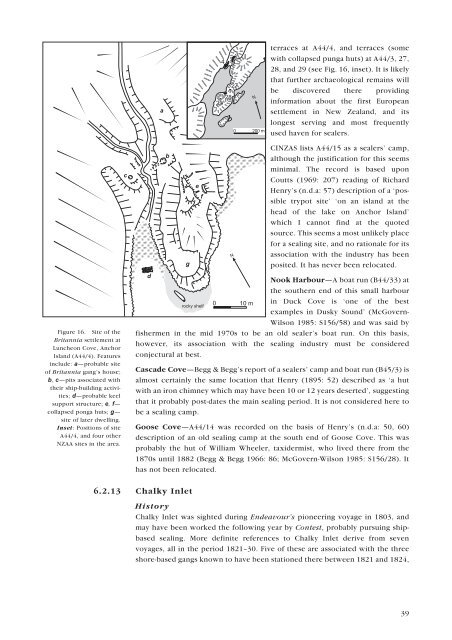The New Zealand Sealing Industry - Department of Conservation
The New Zealand Sealing Industry - Department of Conservation
The New Zealand Sealing Industry - Department of Conservation
Create successful ePaper yourself
Turn your PDF publications into a flip-book with our unique Google optimized e-Paper software.
a<br />
3<br />
4<br />
27<br />
28<br />
29<br />
N<br />
0 200 m<br />
terraces at A44/4, and terraces (some<br />
with collapsed punga huts) at A44/3, 27,<br />
28, and 29 (see Fig. 16, inset). It is likely<br />
that further archaeological remains will<br />
be discovered there providing<br />
information about the first European<br />
settlement in <strong>New</strong> <strong>Zealand</strong>, and its<br />
longest serving and most frequently<br />
used haven for sealers.<br />
Figure 16. Site <strong>of</strong> the<br />
Britannia settlement at<br />
Luncheon Cove, Anchor<br />
Island (A44/4). Features<br />
include: a—probable site<br />
<strong>of</strong> Britannia gang’s house;<br />
b, c—pits associated with<br />
their ship-building activities;<br />
d—probable keel<br />
support structure; e, f—<br />
collapsed ponga huts; g—<br />
site <strong>of</strong> later dwelling.<br />
Inset: Positions <strong>of</strong> site<br />
A44/4, and four other<br />
NZAA sites in the area.<br />
c<br />
d<br />
b<br />
g<br />
e<br />
f<br />
N<br />
CINZAS lists A44/15 as a sealers’ camp,<br />
although the justification for this seems<br />
minimal. <strong>The</strong> record is based upon<br />
Coutts (1969: 207) reading <strong>of</strong> Richard<br />
Henry’s (n.d.a: 57) description <strong>of</strong> a ‘possible<br />
trypot site’ ‘on an island at the<br />
head <strong>of</strong> the lake on Anchor Island’<br />
which I cannot find at the quoted<br />
source. This seems a most unlikely place<br />
for a sealing site, and no rationale for its<br />
association with the industry has been<br />
posited. It has never been relocated.<br />
Nook Harbour—A boat run (B44/33) at<br />
the southern end <strong>of</strong> this small harbour<br />
0 in Duck Cove is ‘one <strong>of</strong> the best<br />
rocky shelf<br />
10 m<br />
examples in Dusky Sound’ (McGovern-<br />
Wilson 1985: S156/58) and was said by<br />
fishermen in the mid 1970s to be an old sealer’s boat run. On this basis,<br />
however, its association with the sealing industry must be considered<br />
conjectural at best.<br />
Cascade Cove—Begg & Begg’s report <strong>of</strong> a sealers’ camp and boat run (B45/3) is<br />
almost certainly the same location that Henry (1895: 52) described as ‘a hut<br />
with an iron chimney which may have been 10 or 12 years deserted’, suggesting<br />
that it probably post-dates the main sealing period. It is not considered here to<br />
be a sealing camp.<br />
Goose Cove—A44/14 was recorded on the basis <strong>of</strong> Henry’s (n.d.a: 50, 60)<br />
description <strong>of</strong> an old sealing camp at the south end <strong>of</strong> Goose Cove. This was<br />
probably the hut <strong>of</strong> William Wheeler, taxidermist, who lived there from the<br />
1870s until 1882 (Begg & Begg 1966: 86; McGovern-Wilson 1985: S156/28). It<br />
has not been relocated.<br />
6.2.13 Chalky Inlet<br />
History<br />
Chalky Inlet was sighted during Endeavour’s pioneering voyage in 1803, and<br />
may have been worked the following year by Contest, probably pursuing shipbased<br />
sealing. More definite references to Chalky Inlet derive from seven<br />
voyages, all in the period 1821–30. Five <strong>of</strong> these are associated with the three<br />
shore-based gangs known to have been stationed there between 1821 and 1824,<br />
39
















